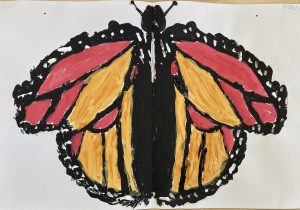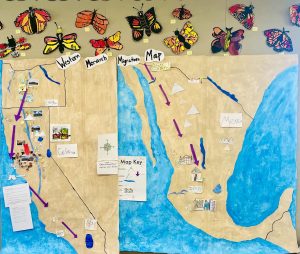Monarch: A Storyline
written by Colleen Vallerga

Student art by Caitlin Vallerga’s class.

Grades: K-5
Total Number of Pages: 37
PURCHASE DETAILS
PDF Storyline Outline – $40.00
The PDF will be emailed to you once the order is received.
Storyline Overview
The Storyline begins with a hook. A scientist from the Deschutes Land Trust in Bend, Oregon invites students to become citizen scientists and work to help the monarch butterflies in their area. She shares information about the amazing monarchs and explains how they are facing many challenges with their numbers declining. Students agree to take on the role of a citizen scientist to help the monarchs.
The citizen scientists begin with a study of the monarch butterfly. Groups conduct research and share information with each other. Students create detailed drawings/paintings of monarch butterflies to add to the frieze.
Teacher/students learn about butterfly migration as they read The Mystery of the Monarchs by Barb Rosenstock. Students create large maps of Oregon, California, and Mexico. They map western monarch migration routes and determine landforms and man-made features the butterflies might encounter as they migrate. Student butterflies are placed on the frieze near Bend, Oregon.
Students envision a typical summer day for a monarch butterfly and create a written narrative of a morning, afternoon, and evening in the life of their butterfly.
Fall arrives and the butterflies prepare for migration. Students consider travel distances, the number of miles a butterfly can fly in a day, as well as butterfly threats to propose daily migration routes for the journey south. The teacher moves student butterflies along on the map as the migration proceeds. Students experience the journey of their butterfly as it travels over land and water, encountering challenges along the way. Students are invited to step into the migration story, sharing their butterfly’s perspective. The teacher guides the students in their imaginings using process drama strategies. Migration writing follows the drama lessons.
The butterflies arrive at their overwintering destination along the central coast of California. A few butterflies continue on to the Oyamel Forests in Mexico. Students explore the butterflies’ overwintering time, adding to the story.
Teacher/students follow the butterflies’ spring migration as they head back to Bend, Oregon. New generations of butterflies replace the old and complete the migration journey home.
When the journey is complete, students reflect on what they have learned. They list challenges that monarch butterflies face in our world and consider ways to support them. Students visit a local garden and learn how to identify and care for the native plants that the monarchs need. They create a monarch way station at their school.
New citizen scientists gather with fellow students, family, and friends. They share what they have learned and present the ways they are supporting the monarch butterflies. They encourage others to help.
Standards and Instruction Covered
Common Core Language Arts
- Reading Literature
- Reading Informational Text
- Speaking and Listening
- Writing
- Language
Next Generation Science Standards
- Interactions, Energy, Dynamics
- Earth’s Systems
- Earth and Human Activity
- Biological Evolution: Unity and Diversity
- From Molecules to Organisms: Structures and Processes
- Ecosystems: Interactions, Energy, and Dynamics
- Heredity: Inheritance and Variation of Traits
- Engineering Design
Oregon Department of Education: Social Sciences
- Geography
- Historical Knowledge
- Historical Thinking
- Social Science Analysis
Oregon Department of Education: Math
• Algebraic Reasoning: Operations
• Numeric Reasoning: Base Ten
Oregon Department of Education: Arts
- Visual Arts
- Theater
Social Emotional Learning
• Integration of SEL skills with the natural world
• Building empathy
• Perspective taking
• Responsibility
• Organizational skills
• Community connections
• Respect for nature

